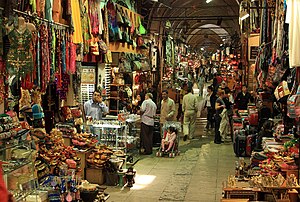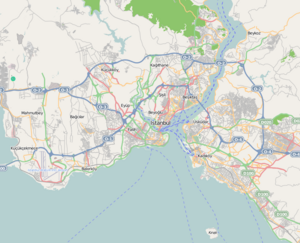Grand Bazaar, Istanbul
| Kapalıçarşı | |

Inside the Grand Bazaar
|
|
| Coordinates | 41°0′38.09″N 28°58′4.56″E / 41.0105806°N 28.9679333°ECoordinates: 41°0′38.09″N 28°58′4.56″E / 41.0105806°N 28.9679333°E |
|---|---|
| Location | Istanbul (historically Constantinople) Turkey |
| Type | Covered Bazaar |
| Beginning date | 1455 |
| Completion date | After 1730 |
| Dedicated to | Sultan Mehmet the Conqueror |
The Grand Bazaar (Turkish: Kapalıçarşı, meaning ‘Covered Market’; also Büyük Çarşı, meaning ‘Grand Market’) in Istanbul is one of the largest and oldest covered markets in the world, with 61 covered streets and over 4,000 shops which attract between 250,000 and 400,000 visitors daily. In 2014, it was listed No.1 among world's most-visited tourist attractions with 91,250,000 annual visitors. The Grand Bazar at Istanbul is often regarded as one of the first shopping malls of the world.
The Grand Bazaar is located inside the walled city of Istanbul, in the district of Fatih and in the neighbourhood (mahalle) bearing the same name (Kapalıçarşı). It stretches roughly from west to east between the mosques of Beyazit and of Nuruosmaniye. The Bazaar can easily be reached from Sultanahmet and Sirkeci by trams (Beyazıt-Kapalıçarşı stop).
The construction of the future Grand Bazaar's core started during the winter of 1455/56, shortly after the Ottoman conquest of Constantinople. Sultan Mehmet II had an edifice erected devoted to the trading of textiles. It was named Cevâhir Bedestan (‘Bedesten of Gems’) and was also known as Bezzâzistan-ı Cedîd (‘New Bedesten’) in Ottoman Turkish. The word bedesten is adapted from the Persian word bezestan, derived from bez ("cloth"), and means "bazaar of the cloth sellers". The building – named alternately in Turkish İç (‘Internal’), Atik (‘Ancient’), or Eski (‘Old’) Bedesten – lies on the slope of the third hill of Istanbul, between the ancient Fora of Constantine and of Theodosius. It was also near the first sultan's palace, the Old Palace (Eski Sarayi), which was also in construction in those same years, and not far from the Artopoleia (in Greek) (Άρτοπωλεία), the city's bakers' quarter in Byzantine times.
...
Wikipedia

